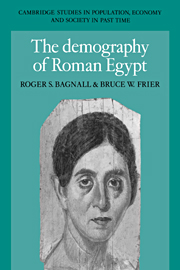Book contents
- Frontmatter
- Contents
- List of figures
- List of tables
- Foreword
- Preface
- A note on references and abbreviations
- 1 The census returns
- 2 The census returns as demographic evidence
- 3 Households
- 4 Female life expectancy
- 5 Male life expectancy and the sex ratio
- 6 Marriage
- 7 Fertility
- 8 Migration
- 9 Conclusion
- Catalogue of census declarations
- Catalogue of census declarations Supplement
- Appendixes
- Bibliography
- Index
- Cambridge Studies in Population, Economy and Society in Past Time
9 - Conclusion
Published online by Cambridge University Press: 06 January 2010
- Frontmatter
- Contents
- List of figures
- List of tables
- Foreword
- Preface
- A note on references and abbreviations
- 1 The census returns
- 2 The census returns as demographic evidence
- 3 Households
- 4 Female life expectancy
- 5 Male life expectancy and the sex ratio
- 6 Marriage
- 7 Fertility
- 8 Migration
- 9 Conclusion
- Catalogue of census declarations
- Catalogue of census declarations Supplement
- Appendixes
- Bibliography
- Index
- Cambridge Studies in Population, Economy and Society in Past Time
Summary
In this book, we have tried to reconstruct the most probable demographic characteristics that surviving census returns support for Roman Egypt. As we have repeatedly stressed, some aspects of the demography of Roman Egypt are baffling, and probably destined to remain so, particularly because of the paucity of our evidence. Unless major new discoveries are forthcoming, the difficulties that surround, for instance, infant mortality, male life expectancy, and the Egyptian sex ratio may well remain insoluble except by way of reasonable conjecture.
By contrast, many important aspects of Egyptian demography are, on present evidence, at least relatively clear. These include especially household structure, the female life table, patterns of female and male first marriage, female fertility rates, the usual means of fertility control, and the way in which these features combined to preserve the delicate balance between mortality and fertility. What is perhaps most surprising about these clearer aspects is this: despite persistent inexactitude in the measurement of detail, there is very little about Egyptian demography that would not have been anticipated, very little that lies outside the boundaries of the normal for pre-modern Mediterranean populations. To be sure, local peculiarities obtrude, of which brother-sister marriage is the most conspicuous example; and allowance must also be made for the usual Greco-Roman social and institutional framework with respect to, especially, slavery, marriage, and infanticide and exposure. But what stands out about Roman Egypt is, in the end, not its oddness but its conformity. The very mundaneness of Egypt gives rise to an expectation that less certain aspects of its demographic regime lie also within the normal range.
- Type
- Chapter
- Information
- The Demography of Roman Egypt , pp. 170 - 178Publisher: Cambridge University PressPrint publication year: 1994



